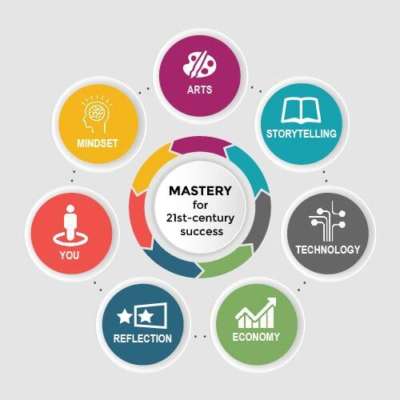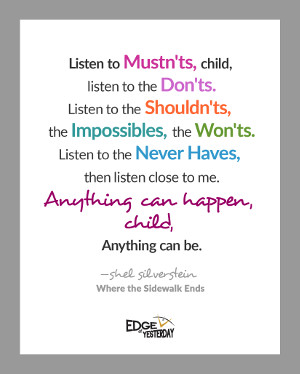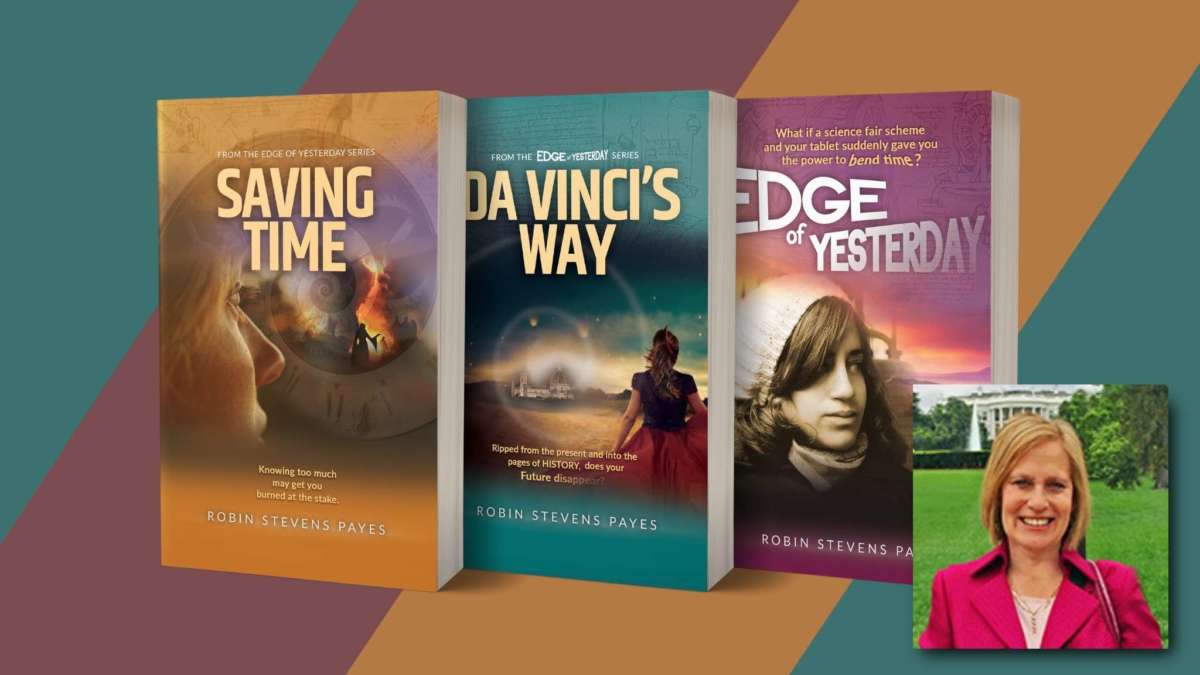“If there’s ever a moment to reinvent learning for life, it’s now.”
So observes Robin Stevens Payes, a social marketing consultant and science writer specializing in reaching — and decoding — teen brains. Payes also is author of the Edge of Yesterday series, whose recently released Saving Time continues the story of young time traveler Charley Morton, lost in the Renaissance and rubbing elbows with Leonardo da Vinci himself. (Read our review here.)
“In adolescence,” says Payes, “young people experiment, separate from family, form new relationships, try on different identities and take risks. When there’s a pandemic going on keeping teens out of classrooms, away from friends, we’re seeing new mental health challenges emerge. Risk-taking today may have deadly consequences.”
“But the pandemic has only exaggerated existing social and economic challenges. Schools designed to train future factory workers for a 19th-century economy don’t work for a world of complex challenges. How do we encourage young people to strengthen their capacity for creativity and problem solving to become a modern-day Leonardo da Vinci?”
In this recent Q&A, Payes elaborated on her ideas for learning and her work with the Edge of Yesterday brand.
Q: You talk a lot about learning through story. Why is that so important, especially for teenagers?
A: We all have stories — who we are, what our families want from us. This is especially true in adolescence when peer pressure kicks in in a big way. “Teen brains” are primed for trying on new identities, pulling away from family norms, taking risks and venturing out into the world. In short, learning.
Charley is an “every teen;” she won’t be limited by others’ expectations. That relatability allows readers to examine their own stories in a new light.
By being exposed to Charley’s attitude of infinite possibilities, I hope readers are able to get a little curious about what it is they could do if there were no limits, and then to seek the skills and opportunities that can help get them a little closer to that dream.
Q: Where did the idea for Charley and time travel come from?
A: When my own kids were entering adolescence, I listened in on all their backseat conversations. They had big ambitions — to be surgeons and soccer pros, become rock stars and make the Olympics. But we insist our kids specialize very early — otherwise, how are they going to get the scholarship to Harvard, and make the connections to get the right jobs?
I wondered if there was a time where cultivating multiple talents and passions was a goal. Discovering the ultimate Renaissance man was a no-brainer. Charley would have to meet Leonardo da Vinci to learn his secrets.
And building his plans for a time machine — that he had neither the technology nor the science to build back in the 15th century — was the obvious middle-school science fair project!
Q: The language of Charley is the language of teenagers. How did you nail that down so perfectly? Were you a teenager in a former life?
A: That’s funny! Everyone goes through those teen years, of course. At the same time, as a science writer, I’ve been writing about learning, cognition, child development and developmental neuroscience for a long time. I like to say I specialize in “teen brains.”
Along the way, I had some good linguistic modelers — my three kids and their friends. My younger son not only embraced teen slang but invented some of his own. Very handy to have a personal, walking-talking Urban Dictionary. Ari was my “teen-speak” consultant.
That said, my three now-adult children are millennials. And teen-speak is always evolving. I keep current on teen-speak through my teen interns and workshops I lead — part of GenZ. Whole different vocabulary and changing cultural references.
Q: Why did you choose da Vinci and the Renaissance as Charley’s destination?
A: The Renaissance was a fascinating time of cultural rebirth, with new technologies (think: printing press) coming online for the first time to make information more widely available. Catholic Church indoctrination gave way to new ideas spread through wider literacy and vast trading routes across Asia and Europe — and ultimately, the Americas.
Compelling to imagine a modern girl to navigate such a deep cultural shift, from our century to that one.
Then, Leonardo da Vinci’s amazing “genius” — art, music, optics, anatomy, engineering, flight, robotics, animation — you name it! In his Codex on the Flight of Birds, he captured modern-day aerodynamics and engineering. He designed a never-before-imagined musical instrument — combination organ, harpsichord and viola. How did he even imagine these things?!
Naturally, Charley wants to learn from the master.
Q: What do you think is the greatest learning obstacle today for teenagers, and how can it be addressed?
A: Learning isn’t just about what happens in school — it’s about growing up resilient and feeling safe, finding a balance between the shelter of childhood and the independence of adulthood.
In adolescence, young people experiment, separate from family, form new relationships, try on different identities and take risks. When there’s a pandemic going on keeping teens out of classrooms, away from friends, we’re seeing new mental health challenges emerge. Risk-taking today may have deadly consequences.
But the pandemic has only exaggerated existing social and economic challenges. Schools designed to train future factory workers for a 19th-century economy don’t work for a world of complex challenges. How do we encourage young people to strengthen their capacity for creativity and problem solving to become a modern-day Leonardo da Vinci?
Finally, who helps teens navigate the environmental, emotional and mental challenges of life? Some families are better at modeling this than others. Schools are starting to get hip to mindfulness for stress management. But the science of learning teaches us how we learn. Among other findings, research suggests that adopting a “growth mindset” — being open to challenges, working hard to master new subjects — has a significant impact overall.
If there’s ever a moment to reinvent learning for life, it’s now.
 Q: Tell us a bit about Edge of Yesterday — the overall brand. What is its mission?
Q: Tell us a bit about Edge of Yesterday — the overall brand. What is its mission?
A: EOY Media, our interactive learning platform, makes learning personal. I run a summer internship program bringing teens together to learn the process of content development and online engagement, researching and developing stories for our interactive “time travelers” portal, learning to write using a form of narrative journalism. Some of the questions they consider in the process: How does history relate to the present? How could new technologies impact the future?
For 2021, we are expanding that capacity through a partnership with an engineering firm, Acquired Data Solutions (ADS), through MASTERY — mindset, arts, storytelling, technology, economy, reflection and you. It recognizes that to prepare youth to meet the challenges of the 21st century, connected learning is the key — everything relates to everything else — and “you” are the focal point.
Q: What message can readers take from Saving Time in particular and the entire Edge of Yesterday series in general?
A: If you don’t like your story, change it. 
While we can’t control what happens to us in life, Charley learns, meeting and interviewing her “heroes of history,” she has control over her experience of it. By that shift of mindset, she learns anything is possible!
Based on this understanding, Charley sets out her own vision to dream her future into life:
“If someone could grant you three big wishes about how you’d like to grow up, what would they be: To be brave in the face of danger? To spread happiness to others? To follow your dream — even if no one else thinks you have a right to?”
Charley’s Three Rules for Dreamers and Doers:
- Listen to your heart
- Believe anything is possible
- Don’t just dream: DO!
https://booktrib.com/wp-content/uploads/2018/07/robin-stevens-payes.jpg
About Robin Stevens Payes:
Robin Stevens Payes is a social marketing consultant and science writer specializing in reaching — and decoding — teen brains. She drove headfirst into parenting teens when her three kids were trying their wings and testing their limits. Since her passion is storytelling, she relished listening in on backseat conversations between her children and their friends. As her kids grew, Payes tuned in to how their language, ideas and attitudes transformed along with their bodies and brains. She lives in Rockville, MD, where she works with teens on STEAM learning — science, technology, engineering, arts and design, and math — and consults with readers on creating new apps, games and storylines. This is her third book in a series for teens.



